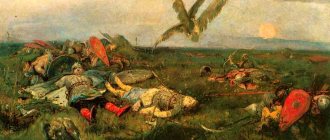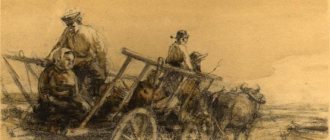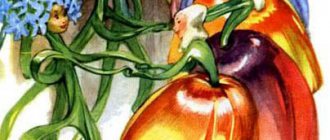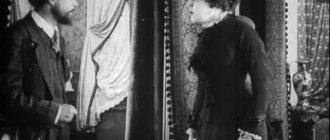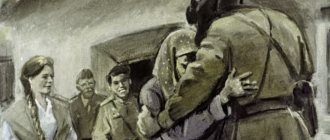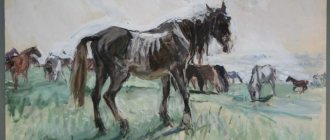Great L.N. Tolstoy wrote his famous story “After the Ball” in 1903, but it was published much later, in 1911, after the writer’s death. The history of the creation of Tolstoy’s “After the Ball” suggests that this work is based on real events that happened to the writer’s brother, Sergei Nikolaevich. Leo Tolstoy, while a university student, lived in Kazan with his brothers Nikolai, Sergei, Dmitry and sister Maria. There, his brother Sergei fell head over heels in love with Varenka, the daughter of the military mayor Koreysha A.P., whose estate was located next door.
The history of the creation of “After the Ball” (L. N. Tolstoy)
Sergei Nikolaevich very often came to visit them and more than once attended their social receptions and balls. But something will happen that will once and for all turn him away from his grandiose plans, extinguish his love and desire to marry his sweet beloved.
One night after the ball, Sergei Nikolaevich became an involuntary witness to how a fugitive soldier was being punished, and Varenka’s father himself supervised this terrible execution.
The story of the creation of “After the Ball” is quite intriguing, and therefore it is still better to familiarize yourself with the full content of the work itself in order to understand all the subtleties and essence of the event that took place. This incident shocked the writer himself, who later, many years later, decided to describe it in his work “After the Ball.”
The idea for the story “After the Ball”
The idea of the story is not to expose the army’s rules, especially since punishment by “driving them through the gauntlet” was stopped after the decree of Alexander II “On some changes in the current system of criminal and correctional punishments” back in 1863. The idea of “After the Ball” is contained in the first sentence of the story: “You say that a person cannot on his own understand what is good and what is bad, that it’s all about the environment, that the environment is eating away.” What does a person’s behavior depend on: his own conscience, inclinations, character or “environment”? For himself, Tolstoy found a solution to this issue. He answered Sholom Aleichem: “the culprit not only of the Kishinev horrors, but of all the discord that settles in some small part - and not the people - of the Russian population is one government ...” (as if it was Nicholas II and his ministers who were chasing the Jews in Kishinev). In the “moral” of the story, he is not so categorical: “Well, do you think that I then decided that what I saw was a bad thing? Not at all. “If this was done with such confidence and was recognized by everyone as necessary, then it follows that they knew something that I did not know,” I thought and tried to find out. But no matter how hard I tried, I couldn’t find out,” that is, “can a person on his own understand what is good and what is bad,” the reader himself must decide
Genre and creative method
So, L.N. Tolstoy presented “After the Ball” as a prose work written in the genre of a short story. It describes one episode from the life of the main character, from which he received a huge shock, which played a big role in his future fate.
The story “After the Ball” depicts the era of the reign of Nicholas I. And the author hints that many years later, in real life, nothing has changed in Russia. Lev Nikolaevich Tolstoy was an idealist; he always opposed oppression and violence against the people. His story and almost all of the work of this great artist of words is connected with Russian realism in literature.
The story of the creation of “After the Ball” describes his serious suffering and torment on this matter, right up to the renunciation of the Christian faith, which he served for a long time. Tolstoy could not come to terms with reality. He did not want to accept the world as cruel and unfair.
L. N. Tolstoy. After the ball. Time and space in literary text
Characterizing the appearance of the colonel, Tolstoy emphasizes that “his face was very ruddy, with a white curled mustache a la Nicolas I, white sideburns brought to the mustache and with combed forward temples.” Comparing the appearance of the colonel, “a servant of Nicholas’s bearing,” with Nicholas I is an important artistic detail of the story. Think about why the writer resorts to comparing the appearance of the colonel with the appearance of the king. How does this comparison develop in the plot of the story “After the Ball”?
By drawing a portrait of a “servant of Nicholas’s bearing,” the author seems to indicate the starting point in revealing his character and life position. For the author, who wrote the story under the impression of his youth, the appearance of the campaigner of Nicholas’s time was alive, which he embodied both in the portrait of the hero of the story, and in his comparison with the appearance of the autocrat. Thus, the author managed to vividly reproduce the Nicholas era.
The portrait of Varenka’s father also speaks about this: “Varenka’s father was a very handsome, stately, tall and fresh old man. His face was very ruddy, with a white curled mustache a la Nicolas I, white sideburns drawn up to the mustache and combed forward temples... He was a military commander, like an old campaigner of Nicholas’ bearing.” The appearance and behavior of the colonel quite fully and uncompromisingly reveals the typical appearance of a martinet of Nikolaev bearing, who behaves and thinks as prescribed.
The hero of the work and narrator Ivan Vasilyevich calls an “incident” from his life “a long story.” But is this really a “long story”? After all, he immediately says that his “life changed in one night, or rather morning.” Read the story and watch how the writer, through the mouth of Ivan Vasilyevich, records the time of the night ball and the day that followed it. What events are these timing indications associated with? What is the time distance between the beginning of the story about the “wonderful” ball and the events that close the story of Ivan Vasilyevich?
We remember that the hero left the ball “at five o’clock, by the time he got home, sat at home, another two hours passed, so when I left, it was already light.” So the morning of the next day was marked for Ivan Vasilyevich with a tragic discovery: from the poetic world he unexpectedly moved into the tragic world of cruelty and lawlessness. And this journey took only a few hours.
Drawing the appearance of the hostess of the ball, the writer emphasizes that she was “in a velvet puce dress, with a diamond feronniere on her head and with open old, plump, white shoulders and breasts, like portraits of Elizabeth Petrovna.” Why does Tolstoy, in the story “After the Ball,” recreate the portrait of the ball hostess three times, each time comparing it with the portrait of Elizaveta Petrovna? To what extent does the mention of Empress Elizaveta Petrovna expand the time boundaries of Tolstoy’s work?
Main topics
The work “After the Ball” reveals the bleak side of the tsarist soldier and his twenty-five-year service in the Russian army, where there was complete lawlessness, constant drills and unbearable punishments in case of failure to comply with any order of the superior. But the main problem still became the issues of moral education of a person and the influence under which it is formed. Is all this simply influenced by chance or by some social conditions? The story of the creation of “After the Ball” describes an example of how one event turns the whole life of the main character, who immediately discarded all the class prejudices of that time. A young man who, like everyone else at this age, is very enthusiastic and impressionable, suddenly, because of a feeling of injustice that washes over him, abruptly changes his fate.
Idea
Systems of images and composition help to reveal the idea of the story “After the Ball.” The main characters here are the narrator Ivan Vasilyevich himself, the old colonel and his daughter Varya.
The history of the creation of Tolstoy’s “After the Ball” suggests that in the image of Colonel Tolstoy decided to expose the social conditions that distort the true nature of a person who is instilled with the wrong concept of duty.
The ideological content of the work is revealed through the main character, the internal evolution of his feelings and perception of the world. He thinks about the problems of responsibility for the entire world around him. The narrator Ivan Vasilyevich is different in that he partially takes on this responsibility for the life of society.
In the story, all the images and actions are described in very contrast: a luxurious ball and a scene of terrible punishment, the graceful figure of the slender Varenka and the soldier’s body, reminiscent of a bloody mess. Or Varenka’s father, who at first looked like a sweet and charming old man, and then turned into an evil despot, demanding that his orders be carried out with dignity.
“After the Ball” (L. Tolstoy)
Quote: “The more in love I was, the more incorporeal she became for me.”
History of creation: the work is based on real events that happened to Leo Tolstoy’s brother Sergei Nikolaevich.
Issues:
The meaning of the title: The title of the story is of great significance: it indicates the double life that the Russian nobility actually led. During the ball - beautiful, decorous, starched, dancing. After the ball (that is, in their ordinary life) - sometimes cruel, inhumane, demonstrating animal behavior.
Literary direction: realism.
Literary genre: story.
Genre features: the genre features of “After the Ball” include the fact that it is actually a “story within a story”: the story, which is the plot, is told by Ivan Vasilyevich as an answer to the question of what is needed for personal perfection.
Time and place of action: since compositionally “After the Ball” is a story within a story, it makes sense to talk separately about the first and second stories. The story, the characters of which are Ivan Vasilyevich’s interlocutors and himself, belongs to the author’s contemporary period (the 70-80s of the 19th century). The story that Ivan Vasilyevich presents to the audience can be attributed to the 40s of the 19th century. The location of the first story is not specified; As for the second story, two significant spaces can be identified in it - the governor’s Maslenitsa ball and the square where the deserter was punished.
Conflict
At the heart of the conflict, on the one hand, lies the duplicity of the mayor Pyotr Vladislavovich, and on the other, the disappointment of the narrator Ivan Vasilyevich. First, in his story, he showers the brightest compliments on the mayor, describing him as a handsome, stately, sweet, amiable and fresh old man who endeared himself to each of the guests. But after the ball, the picture was depressing, the colonel’s face was covered in a cruel grimace, Ivan Vasilyevich saw how he hit a short soldier in the face with his glove, who was trying to soften his blow on the back of the already suffering exhausted fugitive Tatar.
The history of the creation of the work “After the Ball” suggests that the image of Ivan Vasilyevich represents a person who cannot love only one person, he wants to love the whole world and accept it completely. Therefore, love for Varenka immediately turns to ashes because of her father’s act. Because of cruelty and injustice, there is no harmony, and in the end everything collapses. Of course, the young man is not able to change anything, but he can only agree or disagree with the terms of the evil in which he will have to participate in the future. This is what the logic of young Ivan Vasilyevich was based on, which is why he abandoned his love.
Summary of the story “After the Ball”
Summary of the story “After the Ball” and the author’s ideological plan
The main character decides to tell a story that influenced his whole life, changing his attitude towards love, society, and military service. He remembers his student years, full of fun and entertainment.
Being 20 years old, the main character devoted more time not to study, but to balls, festivities and a series of loves, which was facilitated by his wealth and character.
His strongest love was Varenka B., the daughter of a colonel, whom the hero met at social events.
The description of her appearance betrays the sincere awe of the young man. He was delighted even by what was not considered beautiful: tall stature and thinness. He is especially fascinated by the beauty of the girl’s eyes, smile and regal posture. Ivan Vasilyevich mentions that even at 50 years old the heroine retained her beauty and grace.
Having met Varenka at a ball in the house of the provincial leader, Ivan feels a surge of feelings for the girl and sees mutual interest on her part. They dance a lot, and when they have to dance with others, they only see each other. The hero feels euphoria, his love seems to spread to everything around (“I hugged the whole world with my love at that moment”).
The Colonel is asked to dance with his daughter, and he eagerly recalls his skills by dancing the mazurka. Ivan’s enthusiastic attitude towards Varenka is transferred to his father: he seems to him to be a very good person. The hero notes his stateliness, bearing, modest attitude towards himself and generosity towards his daughter, good character and courtesy. He is touched by the colonel's old, out-of-fashion boots.
The ball ends, it’s time to say goodbye, and Varenka gives Ivan her glove and a feather from her fan as a sign of affection.
Arriving home at almost 5 am, Ivan cannot calm down and go to bed. Happiness overwhelms the hero, he loves everyone and sympathizes with everything. He takes pity on his older brother, who still does not know love, takes pity and sends him to sleep further than the sleepy lackey.
Ivan goes outside for a walk, the road leads him to the colonel’s house. Something strange emerges through the morning fog: ranks of soldiers are visible, and the sounds of a flute and drum are reminiscent of the sounds of military exercises “hard, bad music.”
The hero sees a terrible picture of the punishment of a fugitive soldier: a man naked to the waist, tied to guns, is being led through two ranks. Soldiers like him beat him with sticks from both sides. The execution is commanded by the same colonel, Varenka’s father.
The soldier’s back looks like a bloody mess, he writhes in pain and begs: “Have mercy, brothers.” But the soldiers cannot show mercy, otherwise they will face the same punishment. When one of them hits too weakly, the colonel slaps him in the face and threatens him.
Ivan feels that violence fills him with horror. “There was an almost physical melancholy in my heart, almost to the point of nausea, such that I stopped several times, and it seemed to me that I was about to vomit with all the horror that entered me from this sight.”
The young man reflects on the inhuman spectacle, but cannot understand why such violence is possible. The mind finds a “logical” explanation: this is not bad, this is normal, it just doesn’t know some important circumstances.
However, after what he saw, his love for Varenka faded away. And trust was undermined not only in the colonel, but also in the justice of society, in its laws.
